

Study:45% of employees paid under market
ASH PETRIE editor-in-chief
Nearly half of TCC employees are paid below market value, according to a study on compensation and classification the college recently completed.
The study was conducted by reviewing full- and part-time staff positions, the job’s responsibility, the functions performed and its salary.
The board of trustees will review the study’s findings and a new salary grade structure at its Nov. 20 meeting.
Chief Financial Officer Pamela Anglin presented the data summary
The project used employee data beginning in 2023 to May 15.
to the board in August during the 2026 budget meeting. She said the data was incomplete and didn’t include the 2% pay increase employees received in September, but it would be updated when the strategic plan is presented to the board Nov. 11.
“These key investments with implementation of the compensation study will be $4.2 million.
That’s an estimate plus benefits,” Anglin said. “But we have earmarked money to be able to implement the compensation study.”
The salary grade system, if approved, will replace the classification code system for jobs with a new one. Almost all job titles will change, with 80% receiving minor to moderate updates, according to an announcement on insideTCC website. The changes are to better reflect the function of roles to align them with similar positions in other higher education institutions.
Celebrating Día de los Muertos

Cultural event organizers work through state law
inclusion offices on college campuses and dictates how cultural events can be held.
The NW Campus Spanish program had to take a few extra steps to continue to celebrate Día de los Muertos Oct. 30.
NW Spanish associate professor Alejandro Garza said event organizers had to dive into the faculty handbook for the event to be approved by the campus and district.
The handbook has rules that adhere to Senate Bill 17, the state law that bans diversity, equity and
On the events poster there is a circle emblem saying “Welcome” and “All are welcome and encouraged to attend.” This is required to allow cultural events to take place.
“We always follow the policy, and we have a policy for the faculty members and administrators that every event that we have must be open to all, and that’s what we did with this,” Garza said. “Even our flyer has a logo that it has been approved by our campus and the district.”
Another piece of the policy for cultural events to be held is that students who attend the event must do so voluntarily.
“We do not enforce the students to come,” Garza said. “At the presentation, we have students from many different backgrounds, but they all came to be a part of this, and they all came because they wanted to learn and it was voluntary and it was open to everybody.”
NW’s Día de los Muertos celebration started with cultural presentations by other Spanish instructors including Garza, who presented information varying from the impor-
Board member Laura Pritchett asked Anglin in August if the study had been reviewed to make sure the budget wasn’t including funding for unfilled positions.
NORTHEAST
Board of Trustees President Jeannie Deakyne and Vice President Leonard Hornsby are veterans whose service taught them both leadership during vastly different times.
“On the board, we operate as a team. We all represent different voices, but we make decisions as a board,” Deakyne said. “That’s an interesting dynamic very similar to the Army.”
Deakyne is a combat veteran who served as an Army officer from 1999 to 2011, and Hornsby is a Air Force veteran who served from 1972 to 1976 and had 19 years in the reserves.
“Veterans meet so many challenges, some unnecessary,” Hornsby said. “Anytime I can find a place where I can go and find some calm and some understanding about what my experience has been and how it impacted my life is really helpful and important.”
Hornsby enlisted during the Vietnam War.
The military draft during the war required almost all male U.S. citizens and immigrants, ages 18
through 25, to register with the government for mandated service.
“I never saw the Army as a path, so I joined the Air Force so I wouldn’t get drafted,” Hornsby said. “It felt better for me choosing for myself.”
Registered men’s birthdates were assigned “lottery” numbers, and if their number was randomly selected, it meant they were drafted by the Army.
“My goal was to go to college, but when they had drafted through 50, with orders to draft through 100, I just knew that meant my number was going to get called,” Hornsby said. “My lottery number that year was 75.”
The U.S. government drafted 2 million men between 1964 to 1973. Of those men, 30% died in combat, and over 1,500 men remain unaccounted for. The draft has not been active since.
Hornsby was stationed at the Carswell base in Fort Worth for four years.
“I joke, I say I joined the Air Force to see the world, and they sent me all the way from Waco to Fort Worth,” Hornsby said. “Close enough to be at home when I wanted to be home. Far enough away to be away when I needed to be away.”
Growing up, Hornsby went to segregated schools until his senior year when his high school integrated the students into an all-white school.
“I was very angry about that,” he said. “I had a great distrust of people that did not look like me
tance of the way tombs are decorated to how Frida Kahlo memorialized the day in her artwork.
The event headed afterward to the third-floor art exhibit, where the altar contest winner was announced. Students made and entered their own altars, which were judged the week before the event.
After the winners were announced, Garza presented his photography from his visits to Mexico during Día de los Muertos in an artist talk for an exhibit currently at NW.
With Garza, South visual arts
Mary Jantz went to rehab for the first time when she was 19.
But it wasn’t until she entered a court-ordered, intensive outpatient program 20 years later that she was able to admit her drinking was a problem.
“I didn’t walk in thinking I’m an alcoholic,” she said. “[I thought] I’m just allergic to my feelings.” At her first Alcoholics Anonymous meeting, she listened as other members shared their experiences. The first member to speak would later become her best friend and roommate.
“I began to hear parts of my story in their words,” she said. “[My roommate] talked about being terminally unique. The way he talked about it was, ‘If you had been through the s**t that I’ve been through, if you had done the things that I had done, you would drink too.’”
The meeting was her first step toward sobriety. At 41, she has now been sober for three years. Her 23-year battle with alcoholism has prompted her to help others as president of the NE Students in Recovery Club.
“We’re really just a support group at the end of the day,” Jantz said. “Not all of us are in recovery from drugs or alcohol.”
Jantz said the club is a great way to provide students with the support that she received outside of
because of the way we were treated when we got to the school. It was very horrible.” Carswell was where Hornsby gained the ability to trust.
“I learned after I got in the military that people are people,” he said. “Everybody’s got some good

folk. Everybody’s got some bad folk. If you have common goals, then you work well together.” Working with people to achieve the same goal taught him how to be a team player, to respect orders, to trust others and to be selfdisciplined.
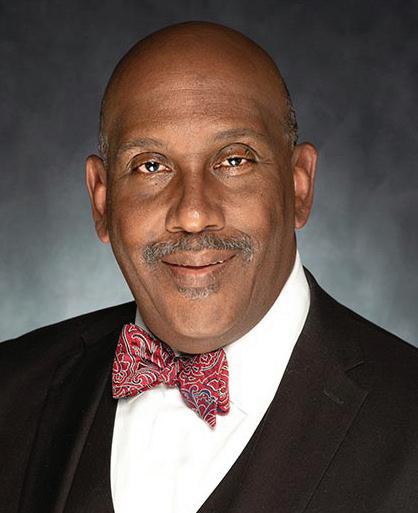
Photo by Kelly Amtower/The Collegian
NE student Gabe Cimajero and NW student Sydney Castillo discuss
in the NW art gallery.
Jeannie Deakyne Leonard Hornsby
Timeline for administering Naloxone
How to slow down an opioid overdose
1:30
If they are still breathing, roll them onto their side and into the recovery position.
0:30
Lay the individual on their back while suppor ting their neck Prepare the nasal spray
1:50










Call 911 Immediately and stay by their side.
1:00
Insert the nasal spray into one nostril and push down on the plunger to release the dose.
2:00
At the two-minute mark, deliver another dose as the ef fects of Naloxone are temporar y. Alternate nostrils with eac h dose.
Opiate epidemic worsens with fentanyl lacing
Students learn how to identify overdose symptoms, help apply aid
by a medical professional has a significant chance of being counterfeit. Counterfeit pills containing fentanyl have even contributed to the deaths of many celebrities including Prince, Mac Miller and Lil Peep.
Over 48,000 fentanyl-related deaths occurred in the U.S. in 2024, accounting for about 60% of overdose fatalities, according to the Centers for Disease Control and Prevention.
For some students, the epidemic strikes close to home.
TR student Landis Hinesly said her sister’s significant other overdosed on fentanyl two years ago.
“He didn’t get to see the birth of his second son,” she said. “That’s what kind of opened my eyes up to the epidemic that’s happening.”
Hinesly is one of the students at TR Campus who learned how to recognize and respond to opioid overdoses during a presentation held Oct. 23. The presentation was led by Hailey Bocanegra, the program director of Challenge of Tarrant County’s Stand Out-Act Responsibly.
Challenge of Tarrant County is a local non-profit organization founded in 1984, comprised of multiple coalitions with the goal of advocating for awareness and prevention of drug abuse. Bocanegra has led multiple fentanyl awareness events for TCC as part of a broader effort to raise awareness about fentanyl and its fatal consequences.
Drug dealers, often referred to as plugs, are now using multiple digital platforms to promote their substances and set up transactions, often using Emojis as code, according to the Drug Enforcement Administration. Dealers having such easy and discreet access can make getting drugs easier than ever, especially for younger people.
Many different Emojis are used to represent pills. A candy Emoji is used for ecstasy or molly, which is frequently found in the rave scene, due to the fact that many ecstasy pills are brightly colored like candy. They are commonly found pressed into various shapes resembling pop culture references or brand logos, such as the character Heisenberg from “Breaking Bad” or the Tesla logo.
Fentanyl has been found laced in street drugs, as well as in many other drugs that society traditionally views as less harmful.
Any pill not distributed to an individual
Recovery
the structure of AA.
“I’m very active in AA and have been from the start, and I wanted to bring that community to school,” she said.
Club adviser Michelle Burris said the club is a no-judgment zone with the underpinning of support that applies to anyone no matter what they are struggling with.
“People have different addictions or struggles, different traumas that they’re recovering from,” she said. “They can share if they want to. If they don’t want to, they don’t have to.” The meetings take place every first and third Tuesday of each month. Most meetings consist of a topic that will open a group discussion.
“Sometimes I’ll do a recovery check-in. ‘Where are you in your recovery?’ And then I always end the topic with ‘How can we support you?’” Jantz said. The topic of their last meeting on Oct. 21 was self-care.
“‘What are you doing that fills your cup?’” she asked in the meeting. “Especially whenever you’re in a helping profession, we
Some fake pills have been found containing over 5 milligrams of fentanyl. Anything over 2 milligrams can be lethal.
“It’s about 13 cents to produce these pills,” Bocanegra said.
Fentanyl was developed in 1959 for medical use such as surgery and severe chronic pain. Like heroin, it is an opioid. However, it is about 50 times more potent. It is also one of the easiest and cheapest opioids to manufacture, due to it being made synthetically in a lab.
According to the DEA, illicit fentanyl labs in China and India export large quantities of the substance to Mexico and Canada, where it is then smuggled into the U.S. From there, drug dealers purchase the pure white powder primarily to mix with other street drugs and increase potency in the most costeffective way.
Fentanyl is commonly found in fake Xanax and even fake Adderall. Neither are opioids, and they are known to be misused by a number of college students.
A 2016 study conducted by the University of Michigan Institute for Social Research found that one in five college students report use an illicit drug other than marijuana in the prior 12 months.
Xanax is usually used to treat anxiety, while Adderall is for attention disorders. These are two conditions many college students struggle with, and when paired with the cost of healthcare in the U.S., some end up purchasing pills from drug dealers.
“Just be careful on what you’re doing and what you’re taking because you never know it could potentially end your life, or it could end your friend’s life,” Bocanegra said.
During the TR presentation, Bocanegra educated attendees on the signs of an overdose, which include slow or absent breathing, discolored lips or fingertips, unresponsiveness and a limp body. She also presented several facts about naloxone and explained how to properly administer the life-saving medication.
Naloxone, commonly known by its brand name, Narcan, is used to reverse an opioid overdose in progress. It can be easily bought
(continued from page 1)
do a lot to pour into others, and we have to be able to refill our cup.”
The club is open to all, and their meetings are confidential.
“We’ve had people in recovery from eating disorders, people dealing with grief. We have people who are just curious and end up joining us for a meeting,” Jantz said. “We’re just there to lift each other up.”
Club member Angela Clark said she joined the club because she is recovering from the disease of addiction that has gripped her for about 15 years.
“I found out that I wasn’t just suffering from a drug problem. I had a moral deficiency,” she said. “It was a spiritual thing.”
Clark said the club focuses on similarities rather than differences.
“We share each other’s stories, and that helps us be an accomplice in one another,” she said. “We can rely on each other to make it right. We have each other’s back.”
Clark said the club members have each other’s best interests at heart because they have all gone through the insidious disease of addiction.

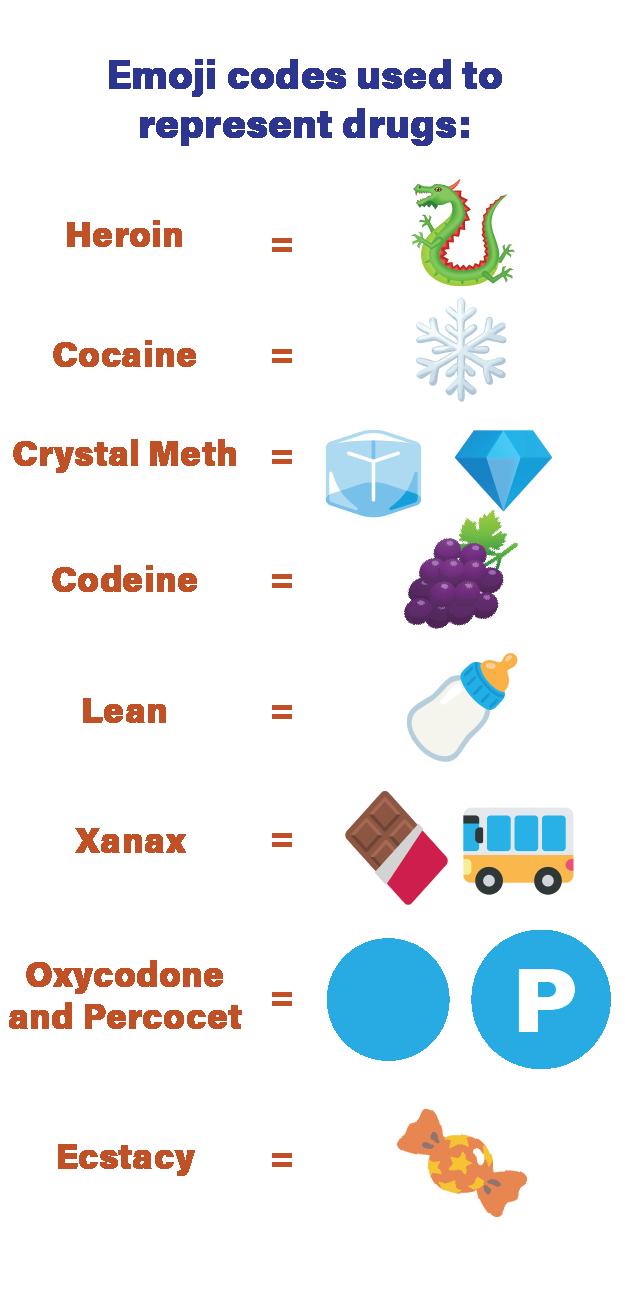
on Amazon for as little as $30, usually coming in the form of nasal sprays. It works by attaching to and blocking opioid receptors in the brain.
Texas Senate Bill 1462, passed in 2015, provides legal protection for people who choose to administer naloxone during an
“Just to hear each other, tell each other stories, that gives us strength and hope,” she said. “We thrive on each other’s message.”
Jantz and Clark are in the Licensed Chemical Dependency Counselor program at TCC, and they both work for the Clearfork Academy, an adolescent treatment facility for boys.
When Clark and Jantz are not in class, they are at Clearfork or in group meetings.
“I wasn’t much older than these boys [when I went to rehab,]” Jantz said. “If I can plant just a mustard seed of a thought that sobriety can be wonderful and beautiful, and that we don’t have to use drugs and alcohol or video games or porn or gambling to run from our feelings, [they can see] that feeling our feelings is a beautiful thing.”
She said she hopes her words of encouragement stick with the boys she works with.
“We don’t have to run from [feelings,]” she said. “If I can be that little voice in their ear that when they do get ready to stay sober, by the grace of God I hope they do, they’ll remember that there was this lady at their first treatment facility who said this.”
emergency.
“Our campus police do carry Narcan, and we have it in our office, so don’t hesitate,” said Angela Hall, coordinator of health services at TR. “You might be the one saving that life.”
Infographics by Kiarah Smith/The Collegian
Infographic by Dom Martinez/The Collegian
MATT PENROD staff writer collegian.editor@my.tccd.edu
Perseverance leads to discovering opportunities
FRANK BONILLA
NE geology instructor Matt Cope has been passionate about geology since he was a child. He shared his journey and encouraged students to follow their passion during a recent interview with The Collegian.
What got you into geology?
I wanted to be a geologist when I first saw volcanic eruptions on videos. I was like, “this is so cool,” and I got to visit a volcano in New Mexico called Mount Capulin. I walked into the crater, and I’m like, “this is so amazing.”
To see them in person but also in movies is just exciting. Just all the stuff the Earth does is, as I said, so cool.
Where did this passion come from?
I definitely have a natural curiosity. I love to figure things out. I love to be able to do a little detective work in a sense that comes with geology. You get to take a little piece here and there of almost a trace evidence of different things, but then you end up being able to find all the interconnections and put together this massive picture that explains so much, and it just feels so good. It’s really satisfying sometimes, but I also like it because it’s interpretive. ... With geology, there’s many possibilities. It’s not set in stone. You almost get a little bit more freedom on being able to utilize your knowledge.
How’d you get your start with geology?
My actual start was at the Fort Worth Museum of Science and History. My mom shared a photo when I was at one of my birthdays, and it was a photo of me digging up a dinosaur bone at this fake dino dig. And she said, “While all the other kids were playing around, you were on your knees focused. Like you were trying to do something.” She’s like, “yeah, I knew you were going to be a geologist.” ... So I knew I wanted to go to college for it. I’ve always had a passion for it. At first, I wanted to go to volcanoes all around the world to see these explosions and see the danger. I wanted to be a part of it, but then I found out I couldn’t do that. I found out oil and gas was exciting — trying to find it, locate it — and so I got to do a little geology in that. So I worked for the Department of Interior for a bit. They manage national parks and all that stuff, but I got to work in the Gulf of Mexico and really see the geological history all the way back, like 50 million years ago, of just like rocks and all this stuff.
What is your favorite experience?
It had to be the summer after my junior year of undergrad when I went to field camp as a required class. We and six other universities
Salary
(continued from page 1)
“The positions that we struggle to fill in many instances are those lower-paying positions, and it’s because we’re not at market,” Anglin said.
In January, the board agreed to increase adjunct pay by $65 per contract hour, and last October, police pay and benefits were updated from an Evergreen Compensation Study. The 2026 budget plan Anglin presented had those amounts built in.
If the board approves the compensation structure, TCC’s Office of Human Relations will analyze the data to ensure accuracy before any updates begin internally.
Once they’re completed, the implementation will begin in January, and any employees with their compensation under market will receive a contract with their updated job description and salary.
CRIME LOG
Oct. 24
SE: An act of stalking was reported on the 2100 Southeast Pkwy. DISTRICT
Oct. 27
South: A report of harassment was made in the South Campus police office.
SE: Theft of property valued less than $100.
Oct. 28
South: Indecency with child sexual contact was reported in the health science building.
South: A report of clergy fondling was made in the health science building.
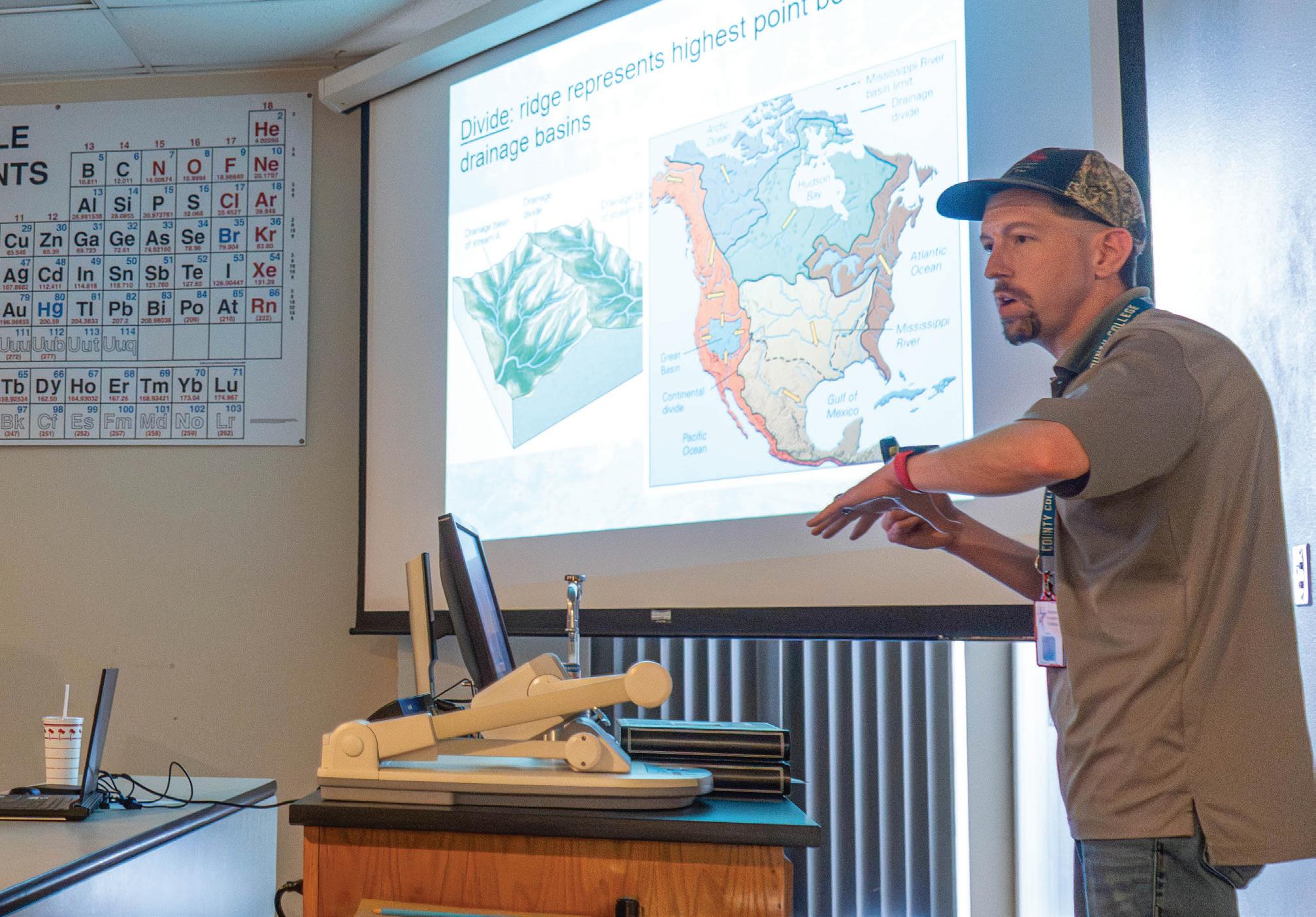
— we were the University of Arkansas — we drove to Montana, in the mountains right near Yellowstone, and it was a town called Dillon. I had a partner from the University of Maine, and he was a tall guy named Glenn McKenney. He was my navigator. We just had to walk across multiple square miles, and I found rocks, a piece of magnetite on the ground, and igneous rock, and I found my birthstone. Then Yellowstone National Park was amazing — glaciers and seeing like massive bears and stuff. It blew my mind, it was so crazy looking, and then there was a volcano underneath. It was kind of scary just to see it even portrayed. How do you stay enthusiastic about geology?
Always keeping up with new developments. I’m part of two geological societies that are professional. One’s since I was a student, which really got me into seeing published articles and people that are studying things all around the world. I just love being able to keep up with what’s new. I love meeting other scientists, because, even if it’s not from a viewpoint that was one of my favorites or something, I always hear it out. My favorite thing is just hearing from somebody that is able to show me something I didn’t even know or even being proven wrong. And I just told my students, “if you guys ever have anything that doesn’t sound right or seem right, you guys are more than welcome to challenge me anytime so I can take note of it and change it because I learn more from you guys then I would
Board
disciplined.
“You’re not always right. You’re not the smartest,” Hornsby said. “If you’re the smartest person in the group, you need a bigger group.”
Even though he never left the country, he said there was still fellowship between everyone in and out of combat.
“There were some things you just knew about the person because they were in uniform,” Hornsby said. “There were commonalities and some things we shared because we were all in the same uniform.”
Deakyne, who got into uniform 27 years after Hornsby, started her military career right out of college. By the age of 26, she was deployed to Iraq as a company commander.
“I was honestly too young to have that much responsibility,” Deakyne said. “My husband and I joke about that a lot.” She met her husband while they were both stationed in Fort Polk, Louisiana, in 1999. They married in July 2001.
“Then, of course, in September the events of 9/11 put a lot of things into action for military
Celebration
(continued from page 1)
families,” she said. “He was immediately deployed to Afghanistan, and I, shortly after, joined him on a series of deployments.”
She spent three years off and on in the Middle East, primarily in Baghdad, Iraq. While each deployment came with different responsibilities, she described her duties as being the Army’s human resources for combat soldiers.
One time, she had to motivate young leaders the same age as her to eat after a rocket attack impacted their dining hall because they were afraid to return.
“You can’t operate under normal conditions, much less combat conditions, if you haven’t fed your body,” Deakyne said. “So, I remember having tough conversations about overcoming fear and making sure were setting a good example for the young soldiers.”
Through managing human life, Deakyne said she learned the depth and pressure of responsibility.
“It really taught me how to lead people and manage systems, not just in general, but under pressure,” Deakyne said. “Be -
(continued from page 1)
adjunct instructor Brenda Melgoza Ciardiello presented her take on the exhibit titled “Raíces y Recuerdos,” meaning “Roots and Memories,” with clay, succulents and plywood.
“This work, which has the family archive and remembrance at its core, was arranged to mirror traditional Catholic Day of the Dead altars in which I treat literal and metaphorical place as material, the female body as an ambivalent sacrifice, and the photograph as a site of resurrection,” Ciardiello wrote in a social media post.
NW arts and humanities dean Lisa Benedetti said that cultural events such as the Día de los Muertos celebration bring language
anywhere else.”
Do you believe anyone can have a passion for anything, and should they seek it?
Sometimes it comes more naturally than others. Mine did come and go. I had it but then it kind of got squished for a little bit when I was starting out because I had some classes that were harder and not as exciting as volcanoes. It was more like sedimentary rocks. Luckily my professors were like, “man, just hold on, it’s going to get more exciting than this.” So I really hung around and persevered, but then I really got reunited because my professor always had stories that I could listen to for hours, like their adventures — crazy unexpected encounters. But I’d say developing it is good. I’ve supported a lot of my colleagues and students, helping them get into a passion, which is what I love to hear because I know if you’re stuck in a rut, it’s hard. But being able to even find a little outlet is so cool because I gave tours, and a lot of students I knew were undecided, so I just said, “if you guys don’t know, don’t rush it. You guys got multiple years to take your basics, so go ahead and use that time to check out different opportunities.” Some people find their passions later than others. ... Keep exploring because you really want to find what your heart feels right with.
cause under those circumstances you’re working in an environment where failure isn’t an option.”
Her last assignment was returning home assigned to UT Arlington as an ROTC instructor, back where she started her journey growing up, this time with
Everybody’s got some good folk. Everybody’s got some bad folk.
If you have common goals, then you work well together ... You’re not always right. You’re not always the smartest. If you’re the smartest in the group, you need a bigger group.
Leonard Hornsby Board of Trustee Vice President
learning to life in powerful and memorable ways.
“When we observe cultural events like Día de los Muertos, participants don’t just read about Spanish-speaking communities, they experience the stories, create the art and connect with the history that makes language meaningful,” she said in an email. “This hands-on learning transforms abstract vocabulary into lived understanding, showing how language carries culture, memory and human connection.”
Students from all walks of life joined in the celebrations including the NW senior learning program and Spanish student Carol Beard. She said it has been hard to build con-
her husband.
“The very first thing we did is we bought our own house, and I was able to paint my walls whatever color I wanted,” Deakyne said. “I did paint a kitchen yellow. That was a big deal. It was kind of my first ‘We’re here. We’ve made it.’” Now, her family unit consists of her husband, two female Golden Retrievers, Bonnie and Posey, and her three daughters.
“The beauty is behind the small things,” Deakyne said. “I don’t regret a single moment that I spent in the military, but it gave me a very strong appreciation for the importance of smaller communities.”
NE Vice President of Student Affairs James Kumm served in the Army for 14 years and is a disabled combat veteran. He said there is a unique understanding coming from walking a similar path, and it’s inspiring knowing the board includes leaders who are also impacted by that service.
“It’s incredibly meaningful to know that,” Kumm said. “Seeing that spirit reflected at the highest levels our institution reinforces what makes TCC special.”
nections outside of the three other students from her class, so she enjoyed interacting with the attendees.
“I love it,” she said. “Just seeing all the young folk enjoy it, I think it’s been cool.”
Other students like NW student Noemi Flores expressed how attending this event allowed Flores to find community and understanding within the art.
“It feels really great to be able to relate to some of the artworks and some of the artists, like their cultural background and their ideas. It helps to find someone to relate to,” Flores said. “I think more people need to find someone to ground them and help them express themselves further, find themselves.”
Photo by Diego Santos/The Collegian
NE geology instructor Mathew Cope teaches about drainage basins during his class.


Student veterans find connections, purpose
by Fred Nguyen

The day was hot even though it was well into October, but it didn’t seem to faze Darren Green as he sprayed down the freshly tilled plant beds. Little white signs poked out from the dirt inside the raised metal garden beds to mark the kinds of plants that will grow there — radish, lettuce, celery and other vegetables.
“Last weekend we went and got the compost. We got, boy, was it 12 bags of compost? 14? Something like that,” Green said. “This week we’re getting all these planted, and hopefully they’ll be ready to donate to the Tarrant Area Food Bank.”
Green is a student worker at the South Veterans Resource Center and president of the South chapter of the Student Veterans of America. The SVA has been planning community projects like planting food to donate to local food banks and volunteering at the nearby veterans home.
“This is Mark and Derek’s baby. I’m just here to support,” Green said.
SVA vice president Mark Power and secretary Derek Cloutier, both student veterans, bring two different types of experience to the project.
Power has a passion for gardening and is pursuing a degree in applied science and horticulture. He has been gardening his whole life.
“I got more plants than you could probably count,” he said. “Anything that I try to do, I usually incorporate nature in some form or try to because of the healing properties of it.”
Power said he came up with the idea for the community project because he and the Veterans Resource Center wanted to give back.
“And what better way to give back than to feed people,” he said. “To be able to come together as a community and be able to feed people is just a beautiful idea.”
Before coming to TCC, Cloutier did non-profit work in Boston for 10 years and built a community where veterans could share their lives in a judgment-free zone. His work was built around using traditional and unconventional therapy to help veterans
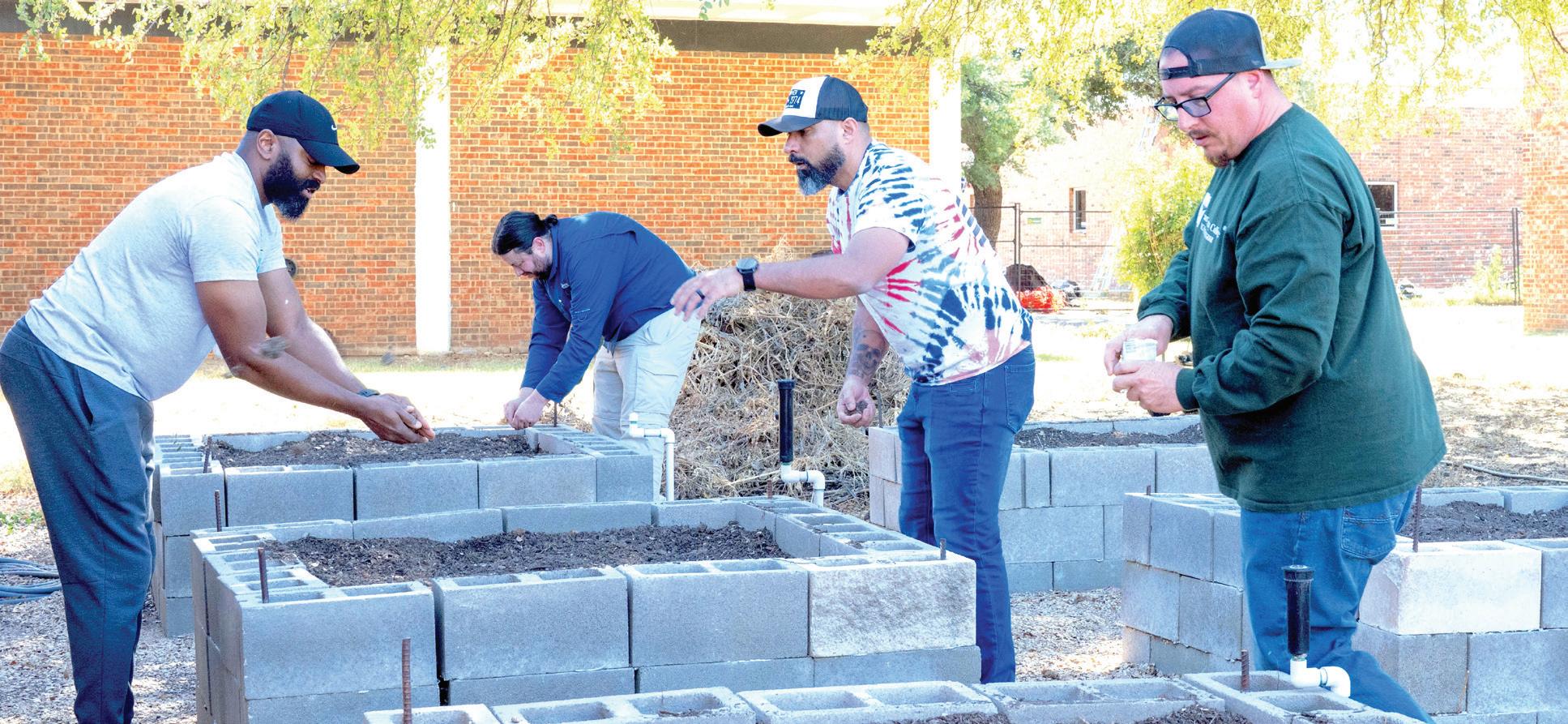
with addiction.
Cloutier said he doesn’t see that kind of community here in Texas.
“That’s what we want to kind of accomplish,” he said. “Bringing the veteran community more together with this SVA chapter, and doing good with it, and helping more vets.”
Green said a lot of student veterans like him try to find opportunities for community outreach.
“The whole reason why we put it together is just to give the veterans that are here a place where they can do not only community outreach, but some sort of therapy through that community outreach,” he said. “SVA just kind of gets us all together.”
SVA is a national non-profit organization that addresses the needs and concerns of student veterans in higher education. With almost 1,600 chapters across the nation, the organization has been on South Campus since the Veterans Resource Center was established.
Veterans counselor Valerie Groll has been at the Veterans Resource Center since it started as a pilot program on South Campus in 2013. She said the center works hard to serve the veterans who come in and help them

navigate things like how to use their benefits.
“It’s important when the veterans come in here that, first and foremost, they feel welcome in here. That this is a safe space for them, but they feel welcome. And that they leave with an answer,” she said.
Green initially started his studies at TCC on SE Campus. He said he came to the South Veterans Resource Center because he wasn’t getting the answers he needed about his scheduling conflicts at SE.
“That’s how I met Valerie,” he said. “She helped me out of a really bad spot, and so I just started coming here, just because it’s a welcoming environment.”
Before coming to TCC, SVA senator Steven Heathman worked on wind turbines and would climb 300 feet every day. When he realized that he didn’t love the work he was doing, he made the decision to go back to school after more than a decade away.
“I was tired of climbing towers. I felt like I wasn’t seeing my kids all the time,” Heathman said. “I had to make my choice.”
Heathman chose TCC South Campus because it was the first place that came up when he searched for the best schools for veterans. He chose to pursue a degree in political science because of his interest in politics that started when he was in the Army during the Obama administration.
“I think every veteran, when they
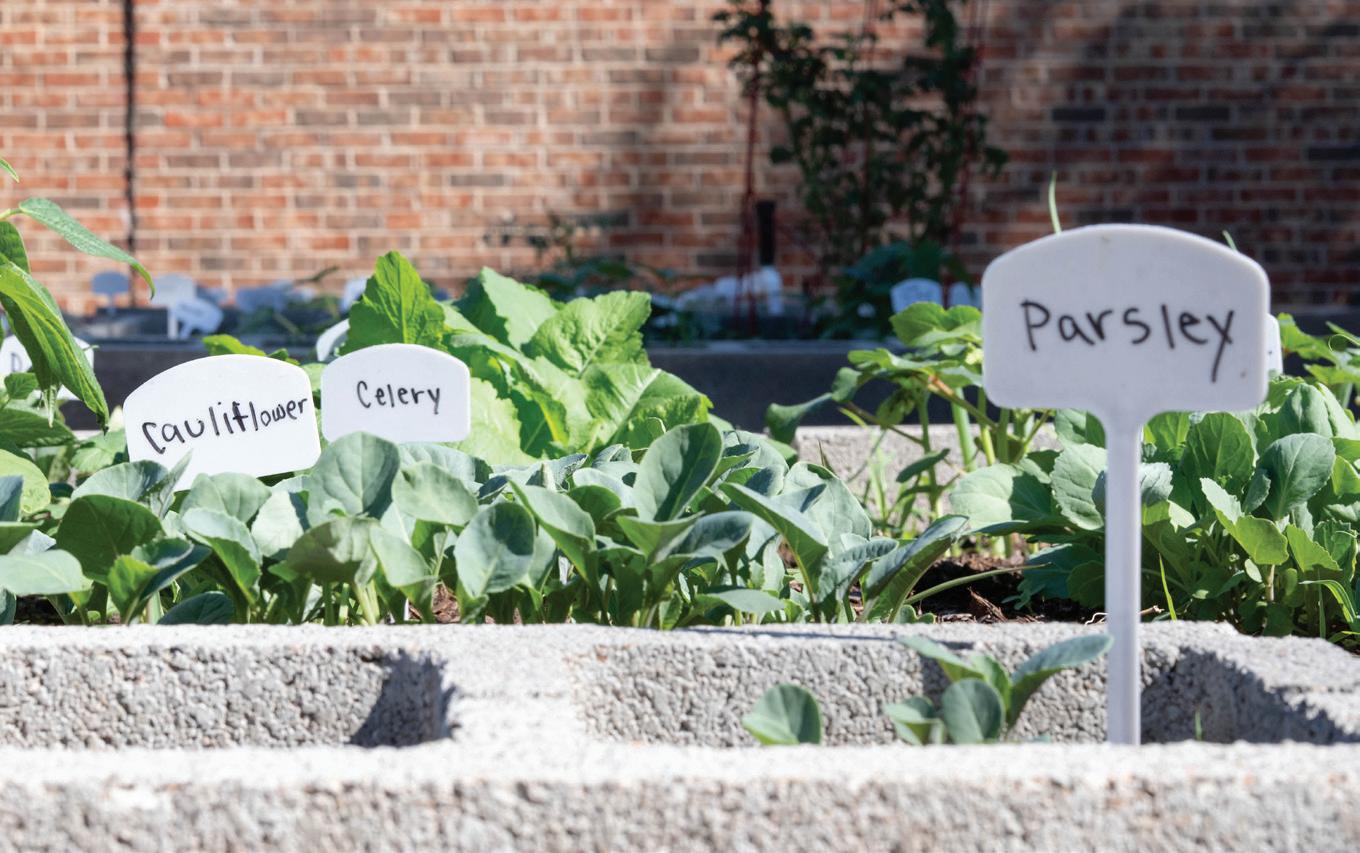

Raised garden beds produce lettuce, cauliflower, celery and parsley to support the Tarrant County
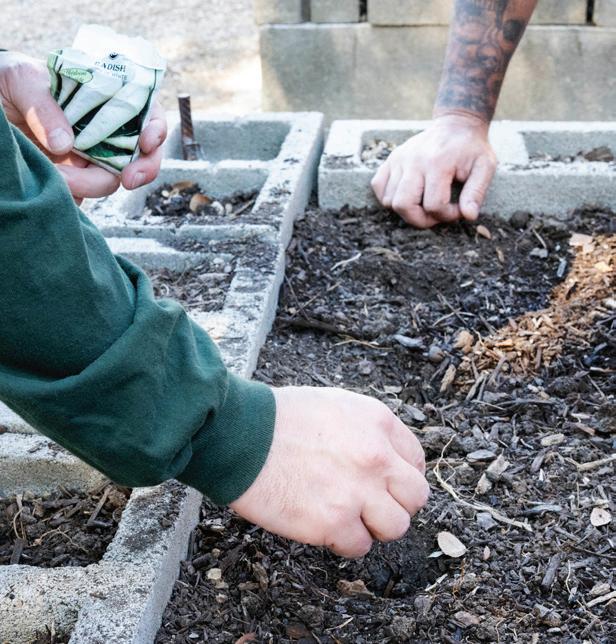
Members of the South Student Veterans of America organization plant radish seeds.
to never be afraid to ask questions, no matter how much experience they have.
“We stall out,” Heathman said. “Every veteran stalls out. We can see that. And if you feel like you’re stalling out at the point, ask us, talk to us and we can help you.”
Power said a lot of veterans struggle with feeling isolated after their service. Community projects like the ones the Veterans Resource Center and the SVA take on can help veterans reconnect with others and give them a sense of purpose.
“It brings the ability for them to connect and come together and rebuild,” he said. “It gives them the ability to get out of the house when a lot of vets are isolated.”
After more than a decade at the

Photos by Kelly Amtower/The Collegian
South student veterans Sylvester Rutherford, Gregory Steinke, Darren Green and Derek Cloutier plant turnip seeds in the garden beds near SMTH on South Campus.
SVA Secretary Derek Cloutier and South student Sylvester Rutherford break up the soil in one of the raised garden beds that benefits the Tarrant County Food Bank.
Food Bank.
Legislation undermines faculty, suppress their voices
Senate Bill 37 does nothing but make the lives of teachers at public institutions harder.
SB 37, which came into effect Sept. 1, significantly changes the way faculty senates operate in Texas and restricts those organizations in almost every way possible.
Faculty senates are now no longer allowed to have more than 60 members unless the governing body of the school approves it. Faculty senates will now have some leaders who are not elected by the faculty themselves but appointed by the governing body. A new office has been established to allow for the filing of complaints against public institutions found in violation of the law.
SB 37 also imposes control over curricula, majors, minors and certificates while limiting the ability of teachers to teach important topics.
What SB 37 does is take away the voices of faculty in the state, and it only spells harm for the already shaky higher education system in Texas.
After the bill was signed, colleges across the state scrambled to find a way to deal with their faculty senates in time for the Sept. 1 date. The UT System chose to end faculty senates in all their universities to comply with the new law and

give them time to rewrite how their faculty senate operated.
TCC chose the same route. In the months after the law came into effect, TCC faculty have been without their faculty senate,
formerly called the Faculty Association. Many have expressed disappointment in their legislators.
It’s not hard to see why. The law only undermines and erodes the way faculty can communicate their
concerns with administration.
Not only that, but this law only adds to the fire to the antagonism between some politicians and faculty. In his State of the State address
Feb. 2, Gov. Greg Abbott said public universities should be held more accountable for what they teach.
“College professors have increasingly pushed woke agendas,” he said. “We need legislation that prohibits professors from having any say over employment decisions.”
The bill comes a year after Senate Bill 17 banned diversity, equity and inclusion initiatives in higher education institutions.
To paint college professors with broad strokes as pushing agendas onto students is wrong. It undermines the important work that they do.
In a 2024 Texas Faculty Association survey, 61% of professors wouldn’t recommend colleagues from out of state for a faculty position in Texas. Many cited their reasoning to be how Texas handles higher education.
More and more faculty across the state are becoming concerned with the state of education in Texas. Yet some legislators keep pushing to limit their voices, dismiss their concerns and further restrict the role of faculty.
Faculty are the reason why these schools exist. Without them, there would be no education, no innovation and nobody to care for the future of our nation.
Growing up in a family full of veterans, I have seen firsthand the effects being a veteran has on them.
Disheartening and joyful stories have been shared, and I heard various viewpoints of how receiving recognition for their service benefits them.
A simple ‘thank you’ is a great gesture but is more like giving someone a Band-Aid to fix a huge wound. My grandfather is a Navy veteran. He joined in 1962 with the thought in the back of his mind that he will be drafted regardless, so he wanted to make the choice himself.
During this time, men were being drafted for the Vietnam War. Some chose to not sit around and wait with the possibility of being chosen for the Army, which would cause them to be sent off to combat. Once you were drafted, there was no choice.
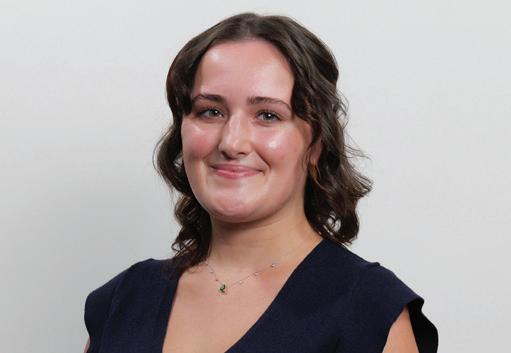
The U.S. Department of Housing and Urban Development estimated that 32,882 homeless people were veterans in 2024.
I have seen within my family how the Veteran Affairs organization can overlook the pain and suffering our veterans endure. For example, only granting selective amounts of resources for covered therapy and medical ser-
vices. The people not granted these things only fall further behind within their health.
The nonprofit organization Honor Flight Network, founded in 2005, flies veterans of all backgrounds to Washington to tour different memorial spaces for free without government funding.
My grandfather was nominated for the Honor Flight and is next on the waiting list to attend the flight in April 2026.
The flights bring veterans to D.C and takes them to different memorial sites.
Non-profit networks and organizations that cater to veterans’ needs are underappreciated and overlooked at times.
There are three separate flights for the Kentucky hub, near where my grandfather lives, and he was told to wait by the phone for the official answer.
He said he is most excited to gain more knowledge of the memorial sites they will visit on the Honor Flight. He said he believes organizations like the Honor Flight network are valuable to veterans.
“I think it’s great, and I think it’s very important,” he said. “It shows the younger generations that the veterans have been appreciated.”
With the Honor Flight being a tour of different memorial sites, this has the potential to show each veteran the impact their dedication and sacrifice has on the U.S.
Being shown appreciation can help each veteran look at their experience with the military in a more positive light.
My father, who is also a Navy veteran, will accompany my grandfather because each veteran selected is granted a guardian to attend with them.
He joined the Navy at the age of 18 with the intention of leaving his hometown in Kentucky and getting the privilege of exploring the world while serving our country. He felt like his hard work was acknowledged when his ship allowed family to visit and experience the same thing the sailors did. He feels honored that there is a possibility for him to attend the flight tour with his father and appreciates the goal behind the organization.
Companies with the means to do so should do more by donating and supporting veteran focused nonprofit networks. If people and businesses that have the means could make donations to groups like the Honor Flight network or even create their own, the number of veterans taken care of would skyrocket.
Being patriotic means loving, protecting and defending the country that you cherish. It means being loyal and having integrity.
While there is nothing wrong with supporting political figures, being patriotic does not mean always agreeing with them.
We should always hold our leaders accountable no matter whom we voted for.
When President Donald Trump pressured ABC to shut down the Jimmy Kimmel show, he did it because he didn’t like what Kimmel said about the way he was handling the loss of Charlie Kirk.
Kimmel pointed out that Trump was more focused on the White House getting a new ballroom than Kirk’s death.
“He is at the fourth stage of grief: construction,” Kimmel said in a joke.
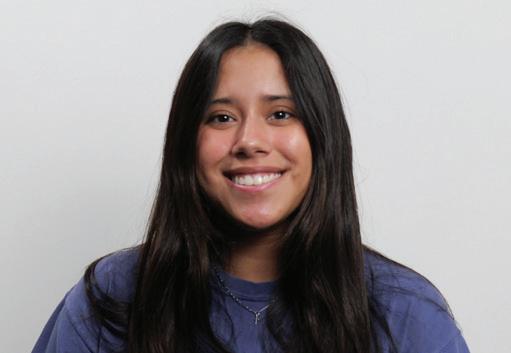
Of course, many people thought the suspension of Kimmel’s show was unnecessary, but there were others who thought Trump was right for pressuring ABC. They praise him, look up to him and think he can do no wrong. The First Amendment protects many rights like freedom of speech, religion, press, assembly and the right to petition the government. Not only is Trump going after

the freedom of speech for civilians, but now he is restricting the press from criticizing him. Journalists are being silenced by new policies and threats.
Defense Secretary Pete Hegseth recently announced new rules for media access at the Pentagon requiring journalists to only report on information “approved for public release.”
This caused many media organizations to turn in their credentials. Even right-leaning Fox News and Newsmax wouldn’t sign the agreement.
Another example is how President Trump and former President Joe Biden have both been pro-Israel, and there hasn’t been a lot of push back from their supporters.
People have their right to believe in what they want without judgment, but is there a moral line when it comes to supporting
a country that is killing innocent citizens?
As a Christian myself, I understand how some people may be pro-Israel because Israel is known as the holy land.
I believe deeply in my faith and in my religion. I even want to visit Israel one day to see the land that Jesus himself stepped on. I understand wanting to protect that sacred ground. But I also believe Jesus wouldn’t support the killing of one another.
I believe that if someone truly had morals, they wouldn’t send billions of dollars to a country that is killing civilians. Unfortunately, America is the country that is funding this war.
I’m a proud American, and I’m very grateful I was born into a country where I can do things many others cannot. I’m proud of being a woman who is getting an education



and can wear whatever she wants. What I’m not proud of is what our country is becoming.
We’re not holding our leaders accountable because we’re scared. We praise them without thinking they can do wrong. We get too passionate about our beliefs and become closed-minded.
We’re not listening to each other or trying to understand other perspectives. We get so caught up in our own lives and think that our beliefs are the right way without critically evaluating the actions of our leaders. Being a patriot in America means standing up for what is right and calling out what is wrong. It means wanting to make the country better for our future generations. The only way this is possible is by speaking up while we still have that right.
Izzie Webb/The Collegian
Sabir Wafeeq says people are more interested in the study of criminal justice because they want to be more informed.
As a professor of criminal justice and adviser for TR’s Law and Order Club, he says students get excited to learn about the possibilities that come from the field of law.
“We try to spend time with students who really want to go on these different pathways and help them figure it out,” he said.
The club does a variety of things, including simulating criminal investigations through games and inviting guest speakers to discuss their work in the criminal justice field.
by Hope Smith
Club President Naomi Lopez said that she hopes to bring more speakers to the club meetings and open engagement for the students.
“I try to make it fun and help them be really close with each other,” she said. “If they have struggles with anything or stuff like that, they can come to me.”
She started as a nursing major but was introduced to the club after taking a class with Steve Romero, a criminal justice professor and the second adviser to the club.
“I was like, ‘This is what I want to do, so I changed my major,” she said. Romero said the club gives stu-
dents opportunities to explore the career they want to do.
“It’s been very rewarding to see our students succeed because at the end of the day we all go to school to get a better job –– a better profession, right?” Romero said.
This year on Nov. 5, TR Campus expects over 50 professionals in the criminal justice field to attend the job fair from 10 a.m. to 2 p.m.
Wafeeq said the Law and Order Club serves as a place for students to find companionship and real opportunity.
“It’s open to any student, and we’ve had students come into a session and they weren’t criminal justice majors at first, but you almost kind of get bit by this bug,” he said.


CAMPUS VOICES
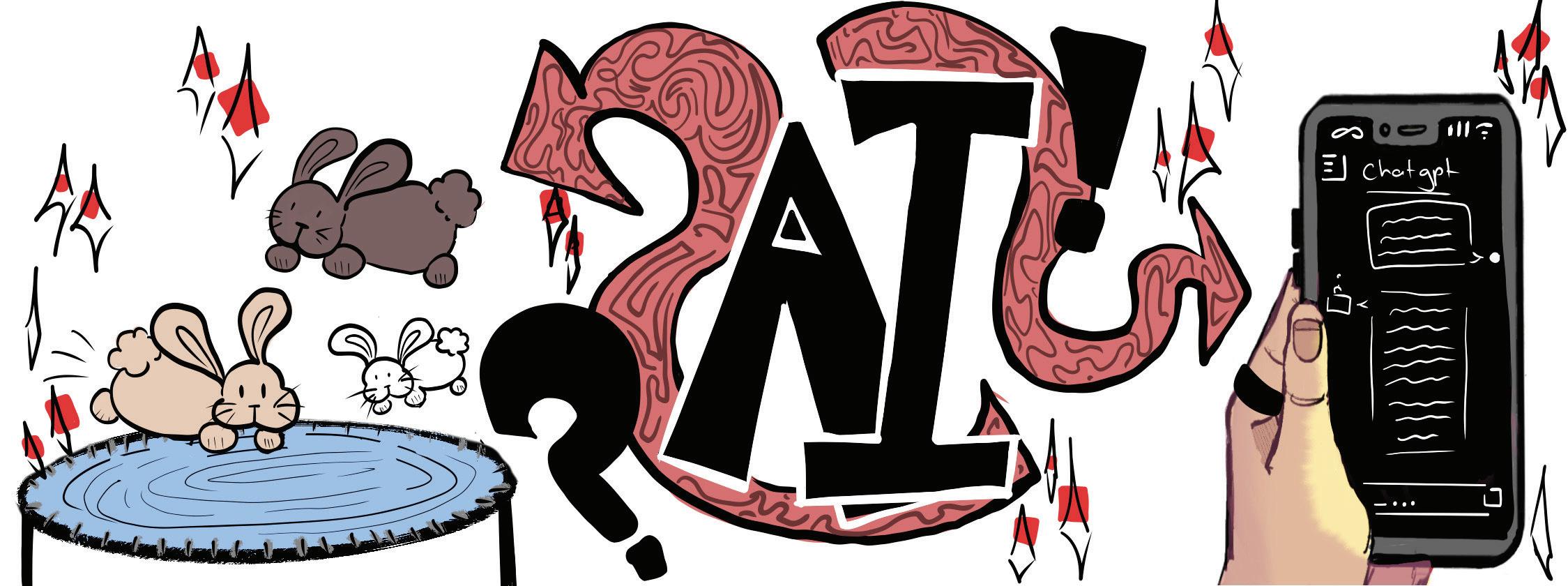
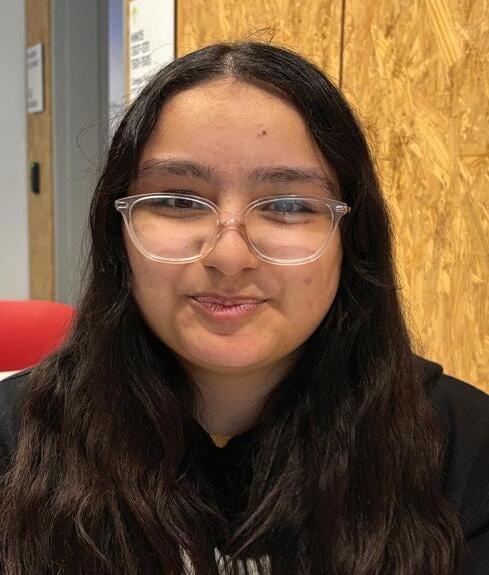
Dinia NW Campus
“It’s kind of crazy because usually you can tell when somethings AI, but it’s gotten really convincing. So I was just like that’s crazy that I actually fell for it. I think it’s helpful but also not very good, because it can take people’s jobs and opportunities.”

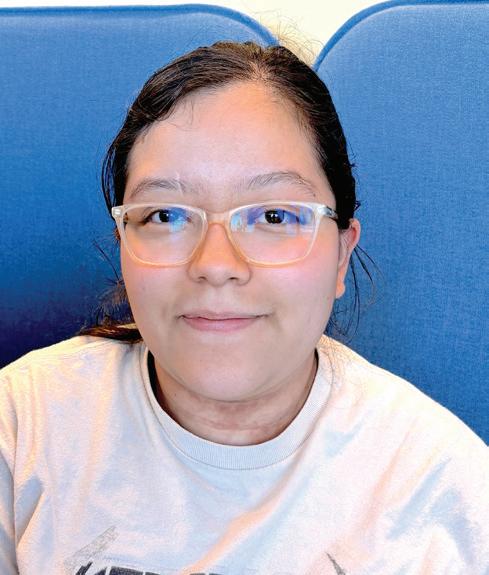
Fernandez NW Campus
“It’s becoming more advanced at fixing flaws that older AI models had, mostly in videos or pictures, or just generating ideas that are unfortunately believable. I’ve seen so many, and there’s a whole new niche on social media where the people are trying to debunk whether the video is AI or not, and I think that’s really scary.”
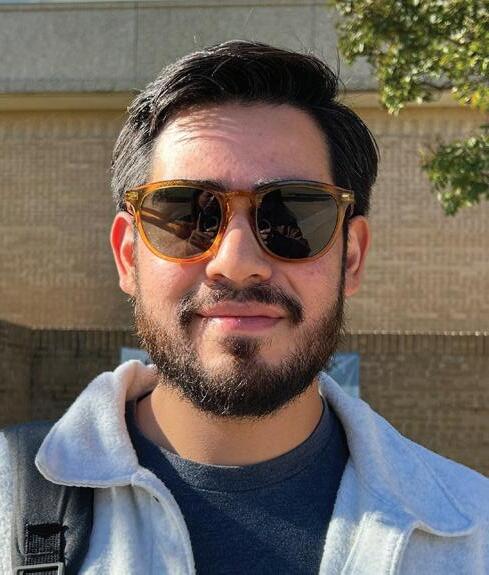
“I think it’s hard to know when you’re being fooled. Fortunately, there hasn’t been a fake [video] that has been pushed as real. I do see that as a possibility in the near future. I do think that is a scary reality. That is a concern that we don’t have regulations on AI. I think there’s a reason to have scrutiny and be a little cautious. Technology is growing.”
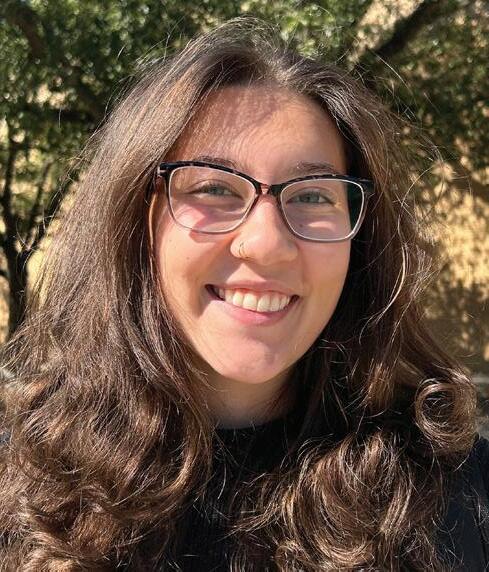
Erin Myers NE Campus
“I’ve seen so many [AI videos.] There’s some on Instagram. They’ve gotten crazier over these last couple weeks. Recently, I feel like I can’t tell. I’ve been fooled by ... a clip of a person, but it’s actually not them, it’s just an AI clip. Or like it’ll be some normal looking cat and then the cat gets up and works out.

Leslie
Maha
Jose Gomez NE Campus
Illustration by Izzie Webb/The Collegian
